On a bluebird Monday morning in late August just after the last big dump of a season in Australia, my colleague and I were heading up the Sponars T-bar at Thredbo chatting all things life and snow.
The conversation shifted to injuries, both of us saying how lucky we’d been over these years having managed to avoid the injury “snow-tax” that it seems most have to pay at some stage.
We stood at the top of our favourite gully just off the T, I remarked how good the upcoming run looked and headed off first (because who likes to wait right?).
Almost immediately into my first turn I felt my tips stop me dead in my tracks, hitting something under the snowpack which sent me double-ejecting over the top of my skis.
My left binding held on for a fraction of a second before releasing, putting all the force through my ankle and causing it to dislocate, with the bottom of my tibia bursting apart at the same time.

And just like that, I finally paid my “snow tax”!
Now approaching three months after my injury, I’m by far no means fully rehabilitated. However having experienced a few home truths as a patient first hand, I thought they would be worth sharing.
Yes it hurts now, but won’t forever
Pain is pretty amazing beast. It commands our attention, threatens our thought patterns and instils fear and doubt in the best of us.
Even with a post-graduate degree that involved a whole semester on pain science, I was still blown away at how many different types of pain my brain could interpret from my nervous system following my injury.
“Hot”, “sharp”, “achy” and “raw” were all words I used to describe to what I have been feeling over the past months.
If I wasn’t already before, I am now acutely aware how worrying this must be for anyone going through his or her own rehabilitation, but rest assure its normal.
It really reinforced the importance of a good sports physio for the length of your rehab journey (lucky I know a good one).
Two steps forward, one step back
As a physio student, my textbooks lead to believe that my patient’s recovery will follow a lovely linear progression of steady improvement based on the weeks and months of tissue healing models that they described.
But tissue healing is just one of the many parts of this very complex process occurring.
Your activity level, rest, sleep, state of mind and mood are all factors that have a part to play here.

I was so excited the first time I was able to ride an exercise bike for 30 mins a few weeks back, only to have my ankle completely seize up the next day and being nicknamed “Peg-leg Pete”.
Rehabilitation involves huge fluctuations in healing and pain, which invariably brings the emotional highs, lows and setbacks with it.
It’s all connected
Anyone who has been through a lengthy rehab process will remember its secondary effects on other parts of the body.
Muscle wasting, joint stiffness and soreness in adjacent tissues are well-understood consequences of injury.
But perhaps what is less well recognised is the impact of an injury on our brains ability to sense where we are in space, or its ability to react quickly.
These lesser known deficits can often slide under the radar in late stage recovery, and their impact on future injury risk and performance is well researched.
It is vital that you partake in a well-rounded rehab program that reflects the demands of your various athletic pursuits.
Get psyched
Another doozy to get your head around is getting back out on the hill once you’ve been given the all clear to do so.
By the time you are ready to hit the slopes again after a lengthy rehab, you’ve had months to mull over the “could have”, “would have” and “should haves” of your injury.
And so understandably this may instil some fear and doubt in us over something like this happening again.
It’s not going to come as a surprise when I say that the best antidote to this is excellent physical preparedness.
We want you to be as robust as possible, and in most cases, even stronger than before your injury in order for you to be really confident both physically and mentally to get out there again.
Not all heroes wear capes
I have encountered some pretty amazing people following my injury. Calm and collected patrollers, my orthopaedic surgeon, friends, family, colleagues and the kindness of strangers do not go unnoticed when you are injured.
The silver lining to this whole process for me is the realisation that I’m lucky enough to have these people around me – so here’s a quick moment to say a thank you to them all.



































Great story that I can relate to. Thanks for the shared insights. Great to hear it from another and a professional. I had a tibia plateau fracture while skiing black runs in Thredbo. Left me with a plate and six screws. Definitely one step forward, two steps back. One specialist said that 90 degrees was acceptable and I should change my expectations. He said I’d never squat again. Thanks to Physio I can now squat. Still some training to go but super optimistic.
Thanks for the comment Perry. And congrats on getting so far with your rehab journey!
I can say two years down the track that I still have to keep on top of my injury but feel confident on returning to the level of skiing I want to 🙂